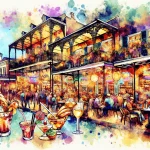Situated in the renowned French Quarter of New Orleans, Jean Lafitte’s Blacksmith Shop stands as a captivating remnant of the city’s storied past. This historic landmark, one of the oldest structures in the area, serves as a window into the early days of New Orleans, offering insights into its colorful history and the legends that have shaped its unique character.
In This Article
TL;DR
- Jean Lafitte’s Blacksmith Shop is considered one of the oldest buildings in New Orleans and a significant historical site.
- The building is associated with the legendary privateer Jean Lafitte and is rumored to have been used for his smuggling operations.
- Today, it functions as a bar, preserving its historical charm while attracting both locals and visitors.
Historical Significance of the Building
Jean Lafitte’s Blacksmith Shop is a rare surviving example of French Colonial architecture, specifically the briquette-entre-poteaux construction style. Built sometime between 1722 and 1732, this structure has withstood the test of time, surviving two major fires that ravaged the city in the late 18th century. Its resilience and architectural significance earned it the prestigious designation as a National Historic Landmark in 1970.
The Legend of Jean Lafitte
The building’s name is inextricably linked to the legend of Jean Lafitte, a notorious privateer and smuggler who operated in the Gulf of Mexico during the early 19th century. According to local lore, Lafitte and his brother Pierre used the blacksmith shop as a front for their smuggling operations, selling contraband goods under the guise of a legitimate business. Their exploits have been romanticized over the years, with tales of daring escapades and battles against authorities.
Lafitte’s legacy is further cemented by his role in the Battle of New Orleans during the War of 1812. It is said that he and his men fought alongside American forces, helping to secure a decisive victory against the British. This act of patriotism has elevated Lafitte to the status of a folk hero, celebrated for his bravery and defiance of authority.
The Transformation Over Time
While the building’s origins can be traced back to the early 18th century, its transformation into a popular bar and restaurant occurred much later. In the mid-20th century, Roger ‘Tom’ Caplinger turned the abandoned shop into Café Lafitte, a bohemian nightspot that attracted a diverse clientele, including celebrities like Noël Coward and Tennessee Williams.
Over the years, the establishment has changed hands and undergone renovations, but its historical charm has been carefully preserved. Today, visitors can step into Jean Lafitte’s Blacksmith Shop and experience a piece of New Orleans’ rich heritage, sipping cocktails and soaking in the ambiance of a bygone era.
Architectural Features and Preservation
One of the most striking aspects of Jean Lafitte’s Blacksmith Shop is its unique architectural style. The briquette-entre-poteaux construction, characterized by brick infill between timber framing, is a rare surviving example of French Colonial architecture in the city. Efforts have been made to preserve these historical elements while maintaining the building’s structural integrity and ensuring its continued use as a popular destination.
Cultural Impact and Popularity
Jean Lafitte’s Blacksmith Shop has transcended its physical boundaries to become a cultural icon, influencing local traditions and popular media representations of New Orleans’ pirate history. The building has been featured in numerous works of literature, including Hervey Allen’s historical novel “Anthony Adverse,” further cementing its place in the city’s collective imagination.
Visitor Experience Today
Stepping into Jean Lafitte’s Blacksmith Shop today is like stepping back in time. The dimly lit interior, illuminated by candlelight, creates an atmospheric ambiance that transports visitors to a bygone era. The bar offers a range of cocktails, including the infamous “Purple Drink” (Voodoo Daiquiri), adding to the allure of the experience.
Visitors can explore the outdoor courtyard, where the sculpture “The Lovers” resides, or venture upstairs to the second floor, rumored to be haunted by a mysterious woman. Whether seeking a taste of history or a night of revelry, Jean Lafitte’s Blacksmith Shop promises an unforgettable experience.
Connections to Other Historical Sites
Jean Lafitte’s Blacksmith Shop is just one of many historical sites that contribute to New Orleans’ rich heritage. Visitors can explore other landmarks like the Ursuline Convent, the oldest building in the Mississippi Valley, or the St. Louis Cathedral, a stunning example of French Renaissance architecture. These sites, when experienced together, offer a comprehensive understanding of the city’s diverse cultural influences and historical significance.
Preservation Challenges and Future Outlook
Preserving a historic building like Jean Lafitte’s Blacksmith Shop in a modern urban environment presents unique challenges. From maintaining the structural integrity of the aging structure to balancing the demands of tourism and commercial operations, ongoing efforts are required to ensure the building’s longevity.
As New Orleans continues to embrace its heritage and promote cultural tourism, Jean Lafitte’s Blacksmith Shop will undoubtedly play a pivotal role. Initiatives to educate visitors about the building’s history and significance, while implementing sustainable preservation practices, will be crucial in safeguarding this iconic landmark for future generations.






